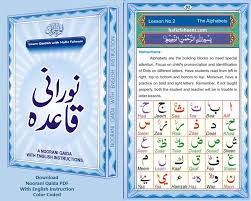business-services

July 16,2025 • 4 min read
Norani Qaida in English: A Complete Guide to Learning Quranic Arabic

The Norani Qaida, often referred to as Noorani Qaida, is a fundamental book used to teach beginners—especially children—how to read the Arabic script of the Quran. Rooted in centuries-old tradition, it offers a structured and systematic approach to learning the proper pronunciation, articulation (Tajweed), and phonetics of Quranic Arabic. Though originally developed in Urdu and Arabic, Norani Qaida in English has gained popularity worldwide, making it accessible to non-native speakers and Muslim communities in Western countries.
What is Norani Qaida?
The Norani Qaida is a pre-Quranic learning tool that breaks down the Arabic language into simple components. It teaches:
-
Arabic alphabet (Harf)
-
Vowels (Harakaat)
-
Joining letters to form words
-
Rules of Tajweed (pronunciation)
-
Sukoon, Madd, Tanween, Shaddah, and more
It serves as a stepping stone to enable learners to read the Quran fluently and correctly with proper pronunciation and rhythm.
Importance of Norani Qaida in English
For non-Arabic speaking Muslims, especially in English-speaking countries, the Norani Qaida in English is a critical educational resource. Here’s why:
1. Accessible Language
Translating the Norani Qaida into English makes it easier for learners to understand the rules and concepts without needing proficiency in Arabic or Urdu.
2. Phonetic Guidance
English transliterations help students pronounce Arabic words correctly, bridging the gap between written and spoken Arabic.
3. Global Reach
Whether in the UK, USA, Canada, or Australia, families use Norani Qaida in English to teach young Muslims how to read the Quran at home or in Islamic centers.
Structure of Norani Qaida in English
The Norani Qaida typically consists of 17 to 20 lessons, gradually increasing in difficulty. Below is a breakdown of its progression:
Lesson 1: Arabic Alphabets
-
Recognition of 29 Arabic letters
-
Each letter is shown in isolated form
-
English transliteration guides pronunciation
Lesson 2-3: Vowel Sounds (Harakaat)
-
Fatha ( َ ), Kasra ( ِ ), Damma ( ُ )
-
Short vowels with proper enunciation
-
Practice of one-letter words with vowels
Lesson 4-5: Tanween and Sukoon
-
Introduction to double vowels (an, in, un)
-
Sukoon ( ْ ) indicating a letter without a vowel
-
Helps in developing rhythm while reading
Lesson 6-8: Letters with Madd and Leen
-
Elongation rules (Maddah)
-
Soft letters (Leen)
-
Examples with translation and pronunciation
Lesson 9-12: Shaddah and Jazm
-
Double consonants
-
Stress on letters (Shaddah)
-
Pausing techniques and rules
Lesson 13-17: Complex Word Formation
-
Joining letters to form words and sentences
-
Practice with real Quranic phrases
-
Introduction to rules like Idghaam, Iqlab, and Ghunna
Benefits of Learning Norani Qaida in English
✅ Builds Strong Quranic Foundation
Students develop a solid foundation in reading the Quran with correct pronunciation, which is critical for understanding and memorizing verses.
✅ Promotes Tajweed Rules
Tajweed is not optional but obligatory (fard) when reading the Quran. Norani Qaida instills these rules from the very beginning.
✅ Enhances Arabic Fluency
With regular practice, learners become fluent in recognizing and reading Arabic, even if they don’t understand the language fully.
✅ Suitable for All Ages
Although primarily designed for children, Norani Qaida in English is equally effective for adults who are beginning their Quranic journey.
Learning Methods
1. Printed Books
Many publishers offer Norani Qaida in English with color-coded Tajweed rules, making it visually engaging.
2. Online PDFs
Free downloadable Norani Qaida PDFs with English translations and transliterations are widely available.
3. Mobile Apps
Interactive apps on iOS and Android offer audio playback, quizzes, and progress tracking to aid in learning.
4. Online Tutors
Virtual Islamic academies offer one-on-one Norani Qaida lessons in English via Zoom or Skype, suitable for global learners.
Teaching Norani Qaida to Kids in English
To keep children engaged:
-
Use colorful, illustrated versions
-
Practice daily in short sessions (15–20 minutes)
-
Incorporate audio-visual aids
-
Offer positive reinforcement and rewards
-
Include parental participation
Our Service010 Details
User Profile
- Full name
- Our Service010
- Email address
- ourservices010@gmail.com
- Join Date
- 2025-07-16
- State
- City
- Pincode
- Address
- Follow us on Facebook
- Follow us on Twitter
- Website Name
- Bio